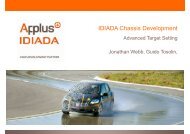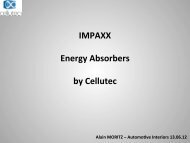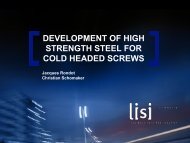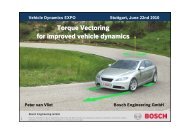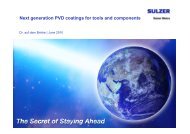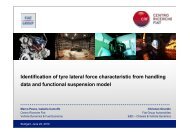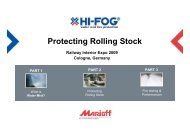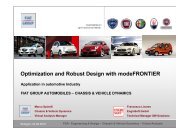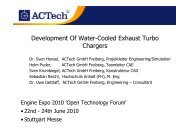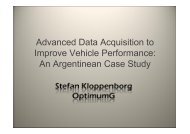Polymer lapping - Ukintpress-conferences.com
Polymer lapping - Ukintpress-conferences.com
Polymer lapping - Ukintpress-conferences.com
Create successful ePaper yourself
Turn your PDF publications into a flip-book with our unique Google optimized e-Paper software.
Surface treatment using<br />
<strong>Polymer</strong> Lapping Technology<br />
Significant reduction of friction losses<br />
Creation of an oil retaining layer in the surface<br />
Alternative and/or improvement to coated<br />
surfaces<br />
NON TOXIC
FriCSo overview<br />
American - Israeli <strong>com</strong>pany: offices in<br />
Detroit & Haifa<br />
Experienced team<br />
Sales & Marketing activities in US, EU & Asia<br />
Under evaluation by over 40 major automotive &<br />
heavy industry corporations
Our Technologies<br />
Nanolayer based surface treatment<br />
technology that significantly reduces<br />
friction between moving parts<br />
Applicable for:<br />
Automotive engine and out of engine parts<br />
(e.g. cylinder liners, pistons, piston pins,<br />
rocker shafts, cam shafts, shock absorbers, etc.)<br />
Hydraulics<br />
Aerospace<br />
Marine<br />
Windmills<br />
Healthcare (artificial implants)
FriCSo Technologie<br />
The activation of the surface, due to the polymer<br />
<strong>lapping</strong>, will take place in the first µm to nm on the<br />
surface. This means that the polymer <strong>lapping</strong> process is<br />
performed as the last mechanical treatment step<br />
(finishing)<br />
FriCSolierungseffekt<br />
Quelle: MTZ 3/2002, Jahrgang 63
Our Products & Surface Engineering Treatment (SET)<br />
<strong>Polymer</strong>-based devices, utilizing existing<br />
in-line, mass production machines<br />
Replacing the existing tools with FriCSo <strong>Polymer</strong> Devices<br />
Using abrasive paste<br />
Surface texturing is added in certain applications
Our CleanTech Solution<br />
Reducing Fuel<br />
Consumption<br />
Reducing<br />
Emission<br />
CleanTech<br />
Solution<br />
Meeting Environmental Regulation<br />
banning the use of hazardous materials (e.g. chrome)
Surface Engineering Treatment (SET)<br />
Application specific treatment<br />
One Step treatment<br />
Two Step Treatment<br />
Two Step Treatment<br />
Grooving<br />
Laser Dimples<br />
Lapping only<br />
Lapping<br />
Lapping<br />
SET-1<br />
SET-2<br />
SET-3
SET1 - <strong>Polymer</strong> <strong>lapping</strong> (One Stage Process)<br />
By applying the FriCSo polymer <strong>lapping</strong> method, a<br />
nanometric organic „active“ layer is formed which is<br />
chemically bonded into the metal surface of the<br />
treated part.<br />
Theuniquecharacteristicof the organic layer is that it<br />
dramatically improves the oil retention characteristics<br />
of the treated surface while improving the surface<br />
topography of the part.
SET2 – Grooving + <strong>Polymer</strong> <strong>lapping</strong> (Two Stage Process)<br />
Surface texturing is done by<br />
using diamond tip (plastic<br />
deformation)<br />
Texturing process is <strong>com</strong>puter<br />
controlled. Surface texture<br />
depends on application.
SET2 – Grooving + <strong>Polymer</strong> <strong>lapping</strong> (Two Stage Process)<br />
AFTER texturing – BEFORE <strong>Polymer</strong>-Lapping<br />
AFTER texturing – AFTER <strong>Polymer</strong>-Lapping<br />
Smooth<br />
shoulder
SET3 – Dimples + <strong>Polymer</strong> <strong>lapping</strong> (Two Stage Process)<br />
Technical Details of laser dimples:<br />
Diameter: 30µ - 120µ<br />
Depth: 1µ - 30µ<br />
Covered area: 1% - 60%<br />
(2 different versions of<br />
texturing method)<br />
<strong>Polymer</strong>-Lapping:<br />
After applying the laser<br />
Dimples it is essential<br />
to remove sharp edges by<br />
polymer <strong>lapping</strong><br />
30μ
Surface Geometry and Surface Topographie<br />
Geometry BEFORE<br />
<strong>Polymer</strong>-Lapping<br />
Geometry AFTER<br />
<strong>Polymer</strong>-Lapping<br />
Topographie<br />
Regular Lapping<br />
Ra = 0.07µm/Rt = 0.25µm<br />
Topographie<br />
FriCSo <strong>Polymer</strong> Lapping<br />
Ra = 0.02µm/Rt= 0.13µm
Topography regular <strong>lapping</strong> vs polymer <strong>lapping</strong>– AFM<br />
(Atomic Force Microscope)
Bearing Area Curve (BAC)<br />
BAC BEFORE <strong>Polymer</strong>-Lapping<br />
BAC AFTER <strong>Polymer</strong>-Lapping
FriCSo “Finger-Print” (XPS)<br />
ThecarbonC1 signalof thepolymer lappedsample<br />
(left) reveals a significant increase of polar<br />
C=O/COOH groups in the upper surface layers<br />
<strong>com</strong>pared with C1s signal of the regular lapped<br />
steel sample (right)<br />
<strong>Polymer</strong> geläppt<br />
Standard
FriCSo “Finger-Print” (optisch)
<strong>Polymer</strong>-Lapping devices for AD / ID<br />
FriCSo polymer <strong>lapping</strong> is<br />
suitable for mass production<br />
machines.
Adaption to machines
In house Tests<br />
Roller on Block<br />
1 drop of oil<br />
variable load<br />
variable speed<br />
seizure at µ=0.3<br />
Special testing machine for piston pins<br />
variable load<br />
variable speed<br />
Temp. up to 250°C
Tribological Investigation: Pin on Disc (COF)
Tribological Investigation: Pin on Disc (friction power)
Tribological Investigation : SOP (Shaft on Plate)<br />
Shaft-on-Plate (ISO 7148/2)<br />
Contact: Line, 9 mm<br />
Movement: Rotation<br />
Speed: 18,8 mm/s, (30rpm)<br />
Load: 30 N<br />
Duration: 50 hrs<br />
Sliding Distance: 3391,2m<br />
Room temperature<br />
Lubrication: 100µl parafinic<br />
Mineral oil without additives
Tribological Investigation: SOP (Shaft on Plate)<br />
Steel vs Brass Investigation WEAR
Tribological Investigation: SOP (Shaft on Plate)<br />
Steel vs Steel Investigation WEAR
Measurement of contact angle<br />
Measurement of wetting angle between<br />
applied liquid (water/diomethan) and the<br />
surface.<br />
The result shows that the wetting angles of the<br />
polymer lapped parts are smaller, which means<br />
improved wettability
Application: Valve Stem (gooving + polymer <strong>lapping</strong>)<br />
Running application in the US - motorsports
Application: Liners<br />
Treatment of liners/full engine blocks – even “high<br />
performance surfaces” like Nicasil have been<br />
successfully treated<br />
Result : Increase in power output<br />
Before FriCSo treatment<br />
After FriCSo treatment
Application: Camshaft<br />
Significant reduction in friction-losses on camshaft<br />
The camshaft is structured in on the main bearing<br />
and <strong>Polymer</strong> lapped afterwards.<br />
Results: up to 26% reduction in friction losses<br />
in actual working conditions
Application: Camshaft<br />
Significant reduction in friction-losses on camshaft
Application: Engine Test (Technion)<br />
Base line - Standard honing<br />
FriCSo Treatment
Application: Engine Test (Technion)<br />
1. <strong>com</strong>pression ring<br />
After baseline<br />
After test with polymer<br />
lapped engine block
Application: Engine Test (Technion)<br />
Base line no Treatment – WEAR<br />
FriCSo treatment – WEAR Option1<br />
FriCSo treatment – WEAR Option2
Application: Engine Test (Technion)<br />
consumption (BSFC, [g/kwh])<br />
Consumption John Deere
Overview various identified engine <strong>com</strong>ponents +<br />
possible treatments
Hydraulic Application – Eliminating adhesion wear<br />
Test Conditions:<br />
-372 bar<br />
-2400 RPM<br />
-180°F<br />
-1,25 Mio. Testcycles<br />
“actual treatment”<br />
“FriCSo Lapping”
THANK YOU<br />
Besuchen Sie uns auf unserem Stand<br />
Halle:7<br />
Stand: 8078<br />
FriCSo Germany<br />
Simon Wright<br />
Tel.: +49-7451-624001<br />
Fax: +49-7451-624004<br />
Email: simon.wright@sw-team.de<br />
URL: www.fricso.<strong>com</strong>



